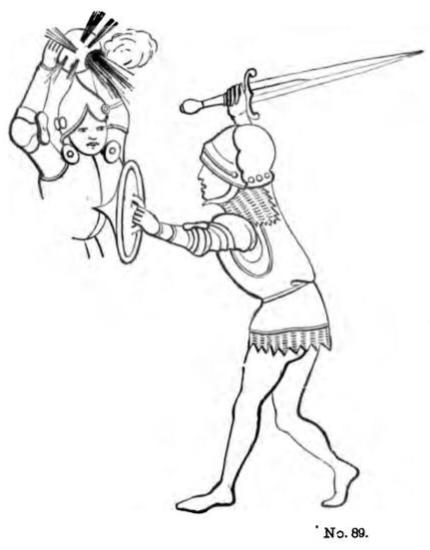
|
MINIATURE from Roy. MS., 18, E, v., fol. 34 [54]vo
The volume is “L’histoire tripartite jusqu’a la mort de l’empereur Hadrien . . . qui fut escripte et finie le xxviie. jour de mars lan de lincamation notre seigner mil iiiie. lxxiii.”
It abounds in subjects illustrative of military arts : among the rest are pictures of knights, archers, crossbow-men, cannon, and a variety of soldiers contending with the “menues armes” of the period.
In the curious sketch before us we have an example of an implement of assault of which we have already noted the existence as far back as the thirteenth century.
The fire-pot of the Arabian treatise described in our first volumeh is here seen in action;
and from the accounts in that old treatise of the analogous fire-weapons, the “massue de guerre,” the “massue pour asperger,” &c., we may gather a pretty accurate notion both of the manner of constructing and applying these diabolical agents.
Both fire-pots and lime-pots were employed at the siege of Harfleur in 1415.
In the “Relation of the Campaign of Henry V.,” printed by Sir Harris Nicolas, we read that the defenders of the city “had warily provided on the walls an abundance of pots full of combustible powders of sulphur, and quicklime to cast into the eyes of our men (the English), if an assault should be made, and vessels of scorching earth and oils, and fat combustibles, for the burning and destruction of our ranks when they should approach to the walls.”
(“Battle of Agincourt,” p. 111.) Compare the miniature from a fifteenth-century Froissart, given by M. Viollet-le-Duc at p. 383 of his Dictionnaire de l’Architecture française.
The chapel-de-fer, made in one piece, with a circlet of bosses or studs, as worn by the left-hand figure, is frequent in this age.
See our plate 101 and Strutt’s Horda, vol. ii. plates 20, 42, 46 and 55.
The figure on the right hand affords a good example of the sword-and-buckler fighter of this day. His helmet is a visored salade.
|

